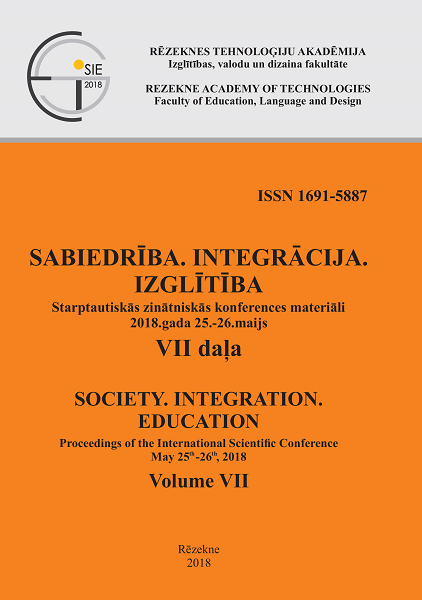STUDENTS’ SOCIAL ACTIVITIES, VALUES, MEANINGFULNESS OF LIFE AND SELF-CONFIDENCE
DOI:
https://doi.org/10.17770/sie2018vol7.3444Keywords:
social activities, discrepancy between importance and attainability of values, meaningfulness of life, self-confidenceAbstract
The purpose of this study was to develop and test a model that describes the relations between participation of students in social activities oriented toward helping others, their values, namely, discrepancy between importance and attainability of values, meaningfulness of life and self-confidence. The sample consisted of 103 students aged from 18 to 41, 28.2% were males and 71.8% were females. In this research the M.Rokeach technique as modified by E.B. Fantalova, the Meaning-in-Life Orientations test (MOL) developed by D.A. Leontiev, the Self-confidence scale of the “Research of self-attitude” questionnaire (RS) developed by V.V.Stolin and S.R. Pantelejew, and questions from the third European Quality of Life Survey, which measure participation in social activities oriented towards helping others, were used. The first three instruments were translated into Latvian by S. Jirgena (now Mihailova). Validity and reliability of the Latvian versions of the MOL and the RS Self-confidence scale were evaluated, and the Latvian versions of both scales were modified. Correlation analysis and structural equation modeling (SEM) were used in order to test a theoretically developed model of students’ participation in social activities oriented towards helping others/ discrepancy between importance and attainability of values and meaningfulness of life outcome, and meaningfulness of life and self-confidence outcome. Firstly, it was found that discrepancy between importance and attainability of students’ values is not related to meaningfulness of life. In its turn, it was revealed that participation in such social activity as doing unpaid voluntary work in education, cultural and professional associations has a positive impact on meaningfulness of life and, in its turn, meaningfulness of life has a positive impact on self-confidence.References
Asagba, R.B., Agberotimi, S.F., & Wimberly, C. (2017). Meaning in life and life orientation as predictors of self-esteem among first-year undergaduate students of a Nigerian University. International Journal of Existential Psychology and Psychotherapy, 6 (1),
http://journal.existentialpsychology.org/index.php/ExPsy/article/view/214/185.
Byrne, B.M. (2009). Structural equation modeling with AMOS. Basic concepts, applications, and programming (2nd ed.). NY: Taylor & Francis Group.
Crumbaugh, J. C., & Maholick, L. T. (1964). An experimental study in existentialism: The psychometric approach to Frankl’s concept of noogenic neurosis. Journal of Clinical Psychology, 20, 200-207. doi:10.1002/1097-4679(196404)20:2<200::AID-JCLP2270200203>3.0.CO;2-U.
Deeley, S.T., & Love, A.W. (2013). A preliminary investigation into the emotion self-confidence model of suicidal ideation in adolescents. Archives of Suicide Research, 17, 161-172.
Erikson, E.H. (1968). Identity: Youth and crisis. NY: Norton.
European Quality of Life Survey (EQLS) (2012). Download from http://eurofound.europa.eu/surveys/eqls.
Farid, M. F., & Akhtar, M. (2013). Self-esteem of secondary school students in Pakistan. Middle-East Journal of Scientific Research, 14(10), 1325-1330. doi:10.5829/idosi.mejsr.2013.14.10.2502.
Frankl, V. E. (1963). Man's search for meaning. An introduction to Logotherapy. NY: Washington, Square Press.
Fernandes, M.G., Vasconcelos-Raposo, J., & Fernandes, H.M. (2012). Relationship between achievement goals, anxiety and self-confidence, and subjective well-being in Brazilian athletes. Motricidade, 2012, 8 (3), 4–18.
Hoffman, R.M. (2006). How is self-confidence related to subjective well-being? Journal of Humanistic Counseling, Education and Development, 45, 186-197.
Jirgena, S. (1999). Jauniešu pašizjūta un adiktīvas uzvedības izvēle. Promocijas darbs. Rīga: Latvijas universitāte.
Kang, K.A., Kim, S.J., & Song M.K. (2009). Relationship of self-esteem, meaning in life, and spiritual well-being in middle school students. Journal of Korean Academy of Child Health Nursing, 15 (4), 343-349.
Keng, C.-J., & Liao, T.-H. (2013). Self-confidence, anxiety, and post-purchase dissonance: A panel study. Journal of Applied Social Psychology, 43, 1636-1647.
Klein, N. (2016). Prosocial behavior increases perceptions of meaning in life. The Journal of positive psychology. Retrieved from
http://home.uchicago.edu/~nklein/ProsocialBehaviorIncreasesMeaning.pdf
Levasseur, M., Richard, L., Gauvin, L., & Raymond, É. (2010). Inventory and analysis of definitions of social participation found in the aging literature: Proposed taxonomy of social activities. Social Science and Medicine, 71 (12), 2141-2149.
Levina, J., Martinsone, K., & Kamerade, D. (2015). Anomia as a factor predicting subjective well-being. Med. Psihol. Ross 3 (32): 3, Retrieved from
http://www.mprj.ru/archiv_global/2015_3_32/nomer07.php/.
Ļevina, J., & Mārtinsone, K. (in press). Anomia, social participation and subjective well-being.
Ļevina, J., Mārtinsone, K., & Kamerāde, D. (2015). Sex and age differences in levels of anomia of Latvian inhabitants. Society. Integration. Education. Proceedings of the International Scientific Conference, 3, 567-576.
Machell, K.A., Kashdan, T.B., Short, J.L., & Nezlek, J.B. (2014). Relationships between meaning in life, social and achievement events, and positive and negative affect in daily life. Journal of Personality. doi: 10.1111/jopy.12103.
Rokeach, M. (1973). The nature of human values. New York: The Free Press.
Schreiber, J.B., Stage, F.K., King, J., Nora, A., & Barlow, E.A. (2006). Reporting Structural Equation Modeling and Confirmatory Factor Analysis results: A Review. The Journal of Educational, 99 (6), 323-337.
Rosová, D., Orosová, O., & Žiaková, E. (2015). The meaning of life, self esteem, and social support of homeless people. doi: 10.15584/978-83-7996-203-7_19.
Tavani, C.M., & Losh, S.C. (2003). Motivation, Self-confidence, and expectations as predictors of the academic performances among our high school students. Child Study Journal, 33 (3), 141-151.
Wilson, J. (2000). Volunteering. Annual Review of Sociology, 26, 215-240.
Wuthnow, R. (1991). Acts of compassion: Caring for others and helping ourselves. Princeton, N.J.: Princeton University Press.
Безумова, Л.Г., & Капцов, А.В. (2009). Зависимость осмысленности от ценностей жизни. Вестник Самарской гуманитарной академии. Серия “Психология”, 1 (5), 19-26.
Леонтьев Д. А. (1992). Тест смысложизненных ориентаций. М.: Смысл.
Леонтьев, Д. А. (2003). Психология смысла. Природа, строение и динамика смысловой реальности. Москва: Смысл.
Столин В.В., & Пантелеев С.Р. (1988). Опросник самоотношения. Практикум по психодиагностике: Психодиагностические материалы. М.: МГУ, 123-130.
Фанталова Е.Б. (1992). Об одном методическом подходе к исследованию мотивации и внутренних конфликтов. Психологический журнал, 13 (1), 107-118.
Фанталова Е.Б. (2001). Диагностика и психотерапия внутреннего конфликта. Самара: БАХРАХ-М.
Фанталова Е.Б. (2013). Диагностика ценностей и внутренних конфликтов в общей и клинической психологии. Клиническая и специальная психология. Retrieved from https://psyjournals.ru/files/58926/psyclin_2013_1_Fantalova.pdf.






